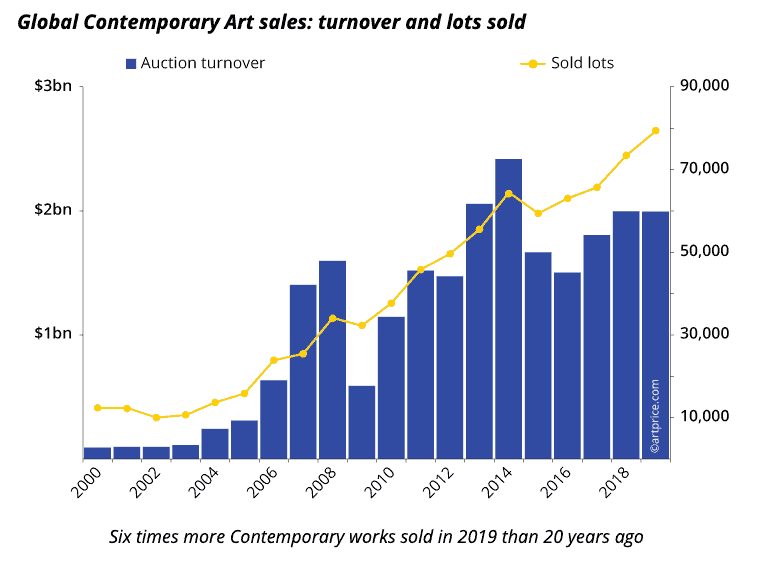The contemporary art market has undergone major development over the past two decades. It has opened internationally to new regions, new narratives and practices, increased numbers of female artists, and affordable artworks. With the internet as its driving force, the globalisation of the economy and culture lies behind this significant change. Before long, contemporary art entered the celebrity and mass-culture realms popularising current works of art and attracting younger audiences towards collecting. Today’s collectors are more and more looking to buy art by living artists encouraged by new creators of taste like brands, celebrities, and social media influencers. Another significant shift in the market that has taken place in recent years concerns the partnership between leading auction houses and art dealers and gallery owners operating in the primary market. This practice greatly influenced contemporary art distribution and allowed collectors to access artwork by up-and-coming artists early in their careers. During the exceptionally challenging 2020, collaborations between primary and secondary markets have intensified significantly, suggesting that this business model is clearly working and will probably remain a long-lasting trend. In short, the global art market has entered a commercial era, with contemporary art as its primary growth driver.
Contemporary Art as Driver of Growth
The 2020 Artprice report on the contemporary art market, which traces its evolution from 1990 to 2020, shows that contemporary art today accounts for 15 percent of the global art market compared to only 3 percent twenty years ago. Over two decades, it has emerged as its primary growth driver with a 2,100 percent increase in auction turnover and $22.7 billion generated. Contemporary art has become the thriving and most profitable part of the entire art market. More artists from all continents are now active in it and new buyers worldwide (many of them being under 40) collect art via more channels, both digital and physical, than ever before.
Even at a time of unprecedented crisis due to the current COVID-19 pandemic, the contemporary art market seems to be performing well. In the “The Global Art Market & COVID 19” report, Citi Private Bank stated that contemporary art made a market return of 6.7% in the first seven months of 2020. The entire art market demonstrated incredible dynamism and adaptability to the new circumstances, switching almost entirely to the internet. Virtual sales quickly filled the gap left by art fairs and retail galleries, resulting in a 4.7-time increase in online sales at leading auction houses in 2020 vs. 2019. We’ve seen the launch of innovative approaches and initiatives to attract new buyers and sell art internationally, from digital viewing rooms to virtual engagement with the art world via video conferencing to live-streamed hybrid auctions. The increase in information and pricing transparency is another major change that occurred during the transition online, which benefits everyone, especially new collectors.

Benefits of Buying Art Online
Since it engages with the general public and adapts quickly to rapid digitalisation, strong sale rates in the contemporary art market come as no surprise. Buying art online provides several advantages that new collectors find especially appealing. First of all, buying online is convenient, easy, and less time-consuming than buying at auctions and traditional galleries. Collectors newer to the market often point out the ability to discover art on their schedule and to transact immediately as a huge advantage of buying online. Accessibility is another significant factor: buying online allows both newcomers and seasoned collectors to explore and buy a far more extensive and more diversified portfolio of artworks compared to the real-life face-to-face purchase. Not everyone can get to an art fair or gallery. Furthermore, a traditional, brick-and-mortar art gallery can display a limited number of artworks, while online galleries offer a greater variety of pieces to choose from, as well as the opportunity to learn more about artists through artist profiles and other informational texts and videos. Some galleries even allow buyers to chat with art advisors and experts or embark on a VR tour of the gallery and its exhibits. Also, buying art online allows new collectors to avoid the often intimidating traditional art world environments, which for many means a lot. Last but not least, it’s less expensive to buy art online with numerous costs such as gallery rent, insurance, fees, and more removed for those operating in the digital space. Additionally, broad public access to artwork prices has made the market more efficient and transparent for new and existing collectors.
New Group of Digitally Savvy Collectors
According to The Online Art Collector Report 2019 conducted by Artsy, 64% of art collectors reported that they had bought art online in the past. Twenty-one percent of online buyers said that they spend 75% or more of their annual art budget online, while 15.3% reported spending between 50 and 74% of their budget online. The trend has only continued since then, and the contemporary segment of the global art market seems most suitable for online sales. According to Artsy’s report, more than half of buyers have been collecting for fewer than ten years, and 32% are under 35 years of age. However, collectors aged between 35 and 44 are more likely to have purchased higher volumes of artworks online. Never before have been more people engaged with art. Alongside the exceptional returns on investment, the new ease, trust, and transparency of buying art online has led to a significant ongoing expansion of people wanting to collect and invest in contemporary art via the most innovative digital platforms.

Things to Consider When Starting Collecting Art
According to wealth managers, a balanced asset portfolio should include art, but before falling for its attractive investment returns, collectors new to the market should consider a few things. The art market can be relatively volatile. The present rise, prevalence, and popularity of the contemporary art market is a trend that will likely perpetuate in the long term (with limited supply from the world’s best artists). Still, trends are often difficult to predict in a short time. The figures quoted, such as 2,100 percent increases in auction turnover, certainly assure us that contemporary art can be an excellent investment, but similar to real estate, the asset requires time to increase in value that can be realised only upon its sale (noting the growth of digital sales makes contemporary art an increasingly liquid asset). Therefore, investing in contemporary art is most attractive and reliable as a medium to long-term investment (3 years and over).
Buy What You Love
Given that you will be living and spending years with your new collection, it is crucial that you buy the art you love. For most collectors buying art is appealing for reasons that transcend potential financial benefits. It’s the passion for art that drives them the most. Even when considering the long-term investment value, they buy art because they love it. Things like the artwork’s aesthetic qualities, the story behind it, and its ability to inspire are the key factors that motivate art collectors to choose art for their collection. The added value that this type of purchase brings is making a cultural contribution, supporting artists, and preserving art for the future, which also may be of interest to collectors. Whatever the motives, the best way to buy art is by following your preference. It’s a personal, passion-led purchase that should reflect you as a person. Buying what you love helps is the first and most meaningful step in defining and creating a collection.
Do Your Research
The next important step is research and finding a reputable company to support your search for art. Alongside them, learn as much as you can about the art you want to collect, the artists, and the broader art market. As an informed collector, you’ll be able to find great artwork that will speak to you as a person and could potentially become a wise investment. By engaging with the right company or companies, you should discover honesty and open discussion around the market, not the old-fashioned obfuscation and barriers you may associate in your mind with the art market.

There’s Something for Everybody
And finally, buy your first piece. There’s something for everybody. You don’t need to be rich to collect art. Anyone can reasonably invest in art on a budget, and there are specialists online, such as Galloire, who are bringing more affordable artworks from the art world’s biggest name to a broader audience. It is natural to start small, both in terms of the number and the size of artworks. Smaller works of art by both established and lesser-known names are more affordable. Many are surprised that limited edition prints and editions yield high multiples of return in the shorter term. In the longer term, if an artist continues on their path to success, then original works have more substantial potential while prints and multiples can reach a ceiling or slow. Often, buying the best and highest value items you can afford (and less of them) is advisable. However, purchase art purely to make a profit is just not a good enough reason to collect. You need to passionate about what you are buying and be able to enjoy it every day. Perhaps you’ll never dream of parting with it.
People Will Always Buy Art
Obviously, the old saying “only a dead artist is a good artist” is now a thing of the past. Contemporary art is one of the most requested genres in the art market today that has overtaken both the Old Masters and 19th-century art. There has never been a better time to invest in it. However, art is much larger than genre trends. People will always buy art because it gives quality to life, lifts our spirits, and brings such inspiration. A considerable part of the “pay-off” is the joy you get each day by seeing it in your home, office, garden (or yacht). Buying art is like an intense love affair. There’s often nothing rational about it, and taste is personal, so what one person loves, you may be indifferent to and vice versa. You can get all the advice in the world about collecting works of art, but at the end of the day, after your research, it has to start by buying what resonates with you. Explore, experiment, take risks, but above all, follow your heart.
